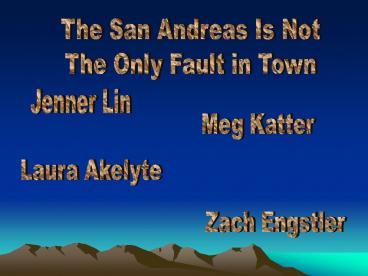Jenner Lin - PowerPoint PPT Presentation
1 / 11
Title:
Jenner Lin
Description:
The fact is that the Pacific Plate Boundary moves an average of 45 mm per year ... Hospitals, skyscrapers, and cities are more vulnerable to life-threatening ... – PowerPoint PPT presentation
Number of Views:18
Avg rating:3.0/5.0
Title: Jenner Lin
1
The San Andreas Is Not The Only Fault in Town
Jenner Lin
Meg Katter
Laura Akelyte
Zach Engstler
2
The San Andreas Fault Is Not the Only Fault In
Town
- When many people think of faults in California,
they think of the San Andreas Fault. - The fact is that the Pacific Plate Boundary moves
an average of 45 mm per year but the San Andreas
Fault moves an average of only 25-35 mm per year. - That means there has to be other fault movement.
3
List of Faults
- San Andreas Fault
- Puente Hills Thrust Fault
- Sierra Madre Fault
- San Cayetano Fault
- Oak Ridge Fault
- Hollywood Fault
- Whittier Fault
- Palos Verdes Fault
- New Port - Inglewood Fault
- San Jacinto Fault
- Ana-Dume Fault
- Compton Thrust Fault
4
- Everyone knows not to build on top of a fault,
but do they know that the land in between two
faults or more can create mountains or bodies of
water? - The type of rock, whether sedimentary or bedrock,
and how close you are to a fault determines how
vulnerable you are to your environmental hazards.
5
Hazards
- Hills shatter into landslides, buildings topple
flat, bridges collapse, pipes burst, and ruptures
are born. Tsunamis rage, grounds sink in
liquefaction, and earthquakes begin. Toxic
contamination and fires spread, and dams break
and flood. - These environmental hazards can cause damage.
When you buy a house in California, what should
you look for?
6
Vulnerability
- When the hazards do happen, some places are
severely impacted far more than others. That
means they are more vulnerable. - Hospitals, skyscrapers, and cities are more
vulnerable to life-threatening situations than
soccer fields or rural lands.
7
Risks
- When you take a chance that is based on your
knowledge of hazards and vulnerability, that is
called a risk. - We take risks everyday to preserve our lifestyle,
especially when it comes to living near active
faults.
8
(No Transcript)
9
(No Transcript)
10
(No Transcript)
11
Conclusion
- Risks are based on hazards and vulnerability,
which these are overlooked by builders who assume
that the San Andreas fault is the only fault in
town. - The more you get to know about the earth you live
on, the lesser risks you can live around.







![READ [PDF] When Blackness Was Golden!: Observations from the front lin PowerPoint PPT Presentation](https://s3.amazonaws.com/images.powershow.com/10073723.th0.jpg?_=20240705079)























